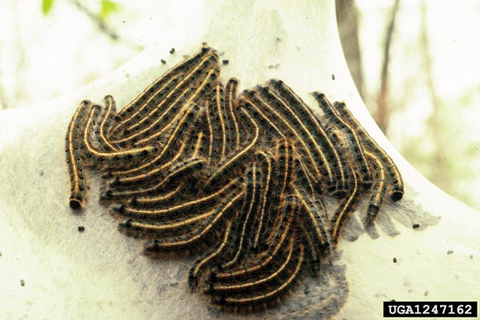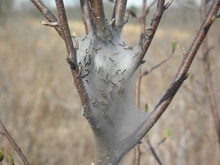Quick facts
- Eastern tent caterpillars are found on fruit trees like apple, chokecherry, crabapple, plum and cherry in May and June.
- The larvae feed on leaves, sometimes defoliating trees.
- Larvae make a noticeable web or ‘tent’ in the fork of the branches.
- The tree is covered in webbing and is defoliated when the caterpillar population is high.
- These caterpillars generally do not affect tree health.
How to identify eastern tent caterpillars
Larvae are hairy with blue, black and orange markings, and a white stripe down the back.
- They are mostly smooth but have a series of hairs sticking out along the sides of their bodies.
- They are two inches long when fully grown.
Damage caused by eastern tent caterpillars
Eastern tent caterpillars feed on tree leaves during the day and will remain in their tents at night and during rainy weather.
- The tents are small at first but will increase in size and can become quite noticeable.
- Healthy, well-established trees can tolerate eastern tent caterpillar feeding.
- Their feeding and webs are cosmetic issues that only affect the appearance of the trees.
- Young trees, as well as unhealthy, stressed trees, suffer more damage. are more susceptible to feeding damage and may need to be protected.
How to protect your trees from eastern tent caterpillars
Pull out the webbing from the trees
Watch for the caterpillars to go back to their tents at the end of the day or when it rains.
- Pull out the webbing along with the caterpillars.
- Bury or bag them to properly dispose them.
- You could burn them if it is permitted where you live.
Using pesticides
If you plan to use pesticides, do so when the caterpillars are less than one inch or less. As they get to their full grown size (two inches), the pesticides might no longer be effective.
When choosing pesticides, consider using a product that has a low impact on the environment.
Some products that can control caterpillars are:
- Residual pesticides
- Spinosad
- Insecticidal soap needs to directly contact the insects and repeat applications might be required, since there is no residual activity.
- Bacillus thuringiensis is a good option if the tree is flowering as it will not harm visiting honey bees and other pollinators.
CAUTION: Mention of a pesticide or use of a pesticide label is for educational purposes only. Always follow the pesticide label directions attached to the pesticide container you are using. Remember, the label is the law.
Reviewed in 2018




